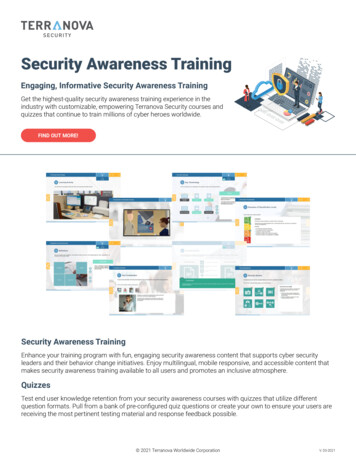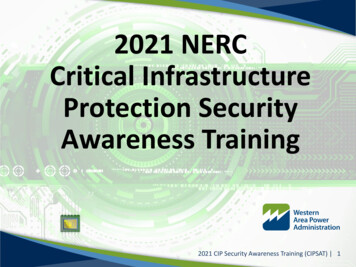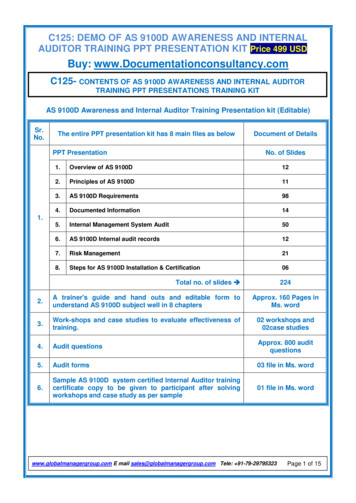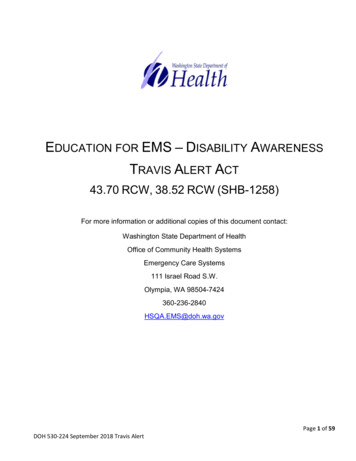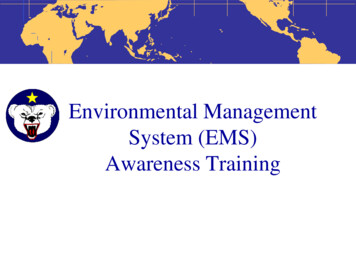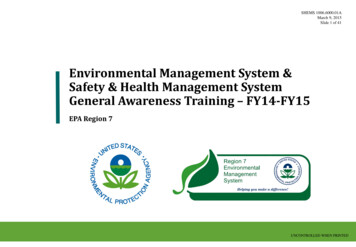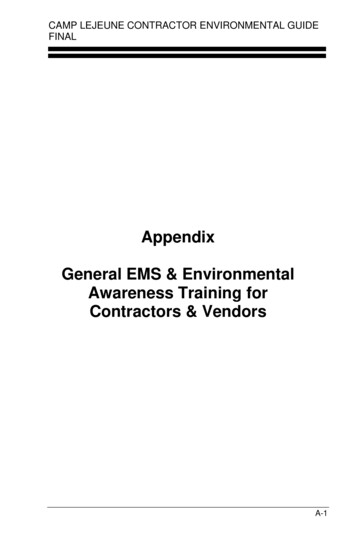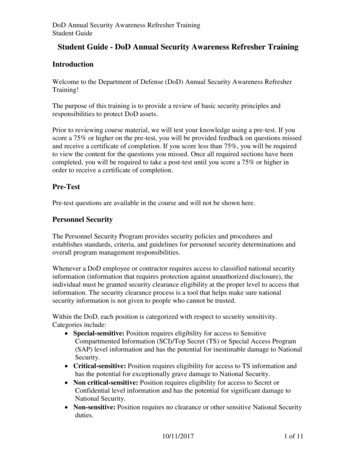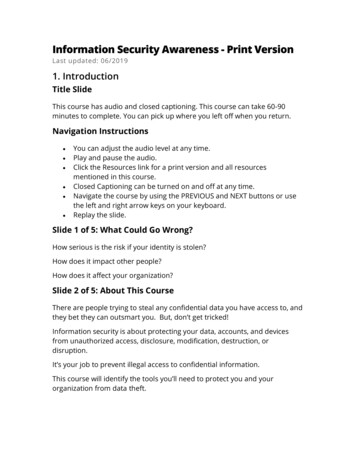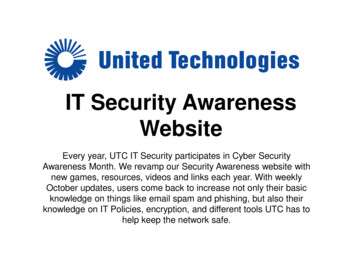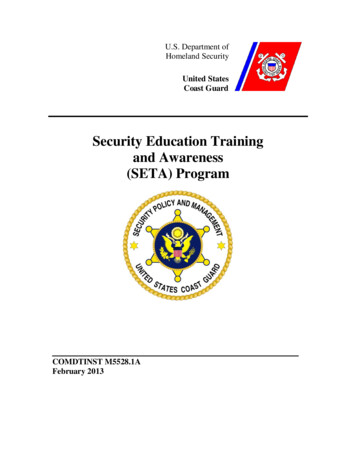
Transcription
U.S. Department ofHomeland SecurityUnited StatesCoast GuardSecurity Education Trainingand Awareness(SETA) ProgramCOMDTINST M5528.1AFebruary 2013
ICommandant2100 Second Street S.W.WASHINGTON DC 20593Staff Symbol: DCMSPhone: 202-372-4546Fax: 202-372-4973Deputy Commandant for MissionSupportUnited States Coast GuardCOMDTINST M5528.1A25 February 2013COMMANDANT INSTRUCTION M5528.1ASubj: COAST GUARD SECURITY EDUCATION, TRAINING, AND AWARENESS(SETA) PROGRAMRef:(a)Department of Homeland Security (DHS) Instruction 121-01-011,Administrative Security ProgramCoast Guard Counterintelligence Program, COMDTINST 3850.1Telecommunication Manual, COMDTINST M2000.3Guard Security and Information Assurance Manual, COMDTINSTM5500.13 (series)Personnel Security and Suitability Program, COMDTINST M5520.12(series)Classified Information Management Program, COMDTINST M5510.23(series)Executive Order 13526, Classified National Security InformationPhysical Security and Force Protection, COMDTINST, M5530.1 (series)Operations Security (OPSEC) Program, COMDTINST M5510.24Department of Homeland Security (DHS) Management Directive Number11042.1, Safeguarding Sensitive but Unclassified (FOUO) InformationDepartment of Homeland Security (DHS) Management Directive Number11056.1, Sensitive Security InformationCoast Guard Industrial Security Program, COMDTINST 5520.13 (series)(b)(c)(d)(e)(f)(g)(h)(i)(j)(k)(l)1. PURPOSE. This Manual establishes the United States Coast Guard SETA Program.The program is designed to facilitate the implementation of the SETA requirementsand standards contained within the full range of security disciplines that comprise theCoast Guard Security Program: Physical Security (PHYSEC), Information Security(INFOSEC), Personnel Security (PERSEC), Operations Security (OPSEC), IndustrialSecurity, and Antiterrorism and Force Protection (AT/FP).aABCDEFGHXXXXXDISTRIBUTION – SDL No. 162bcdefghXXXXXXXXXXXXXXXXXXXXXXXXXXXXXXXXXXXNON STANDARD XXXXXXXXXXXXXsXXXXXXtuvwxyzXXXXXXXXXXXXXXXXX
2. ACTION. Area and district commanders, commanding officers of headquarters units,assistant commandants for directorates, Judge Advocate General, and special staffoffices at Headquarters shall ensure compliance with the provisions of this Instruction.Intranet release authorized.3. DIRECTIVES AFFECTED. This manual replaces COMDTINST M5528.1, SecurityAwareness Training and Education, dated 3 August 1993.4. BACKGROUND. The overall effectiveness of Coast Guard security is largelydependent on establishing a firm foundation of training and awareness. The SETAProgram provides that foundation.5. CHANGES. Changes will be issued as Commandant’s Notices. Time sensitiveamendments will be promulgated by ALCOAST, pending their inclusion in the nextchange to this manual.6. FORMS/REPORTS. The forms referenced in this Manual are available in USCGElectronic Forms on the Standard Workstation or on the Internet:http://www.uscg.mil/forms/; CGPortal g/References; and Intranet athttp://cgweb.comdt.uscg.mil/CGForm.7. RECORDS MANAGEMENT CONSIDERATIONS. This manual has been thoroughlyreviewed during the directive clearance process and it has been determined that thereare records scheduling requirements, in accordance with Federal Records Act, 44U.S.C. 3101 et seq., NARA requirements and records created by compliance with therequirements of this manual, will be maintained in accordance and Information andLife Cycle Management Manual, COMDTINST M5212.12 (series).8. ENVIRONMENTAL ASPECT AND IMPACT CONSIDERATIONS. The potentialenvironmental impacts of this action has been carefully considered and found to becovered by Categorical exclusion 1 e (Figure 2-1 COMDTINST 16475.1E) as it is aguidance document that implements, without substantive change, the applicableCommandant Instruction, procedures, manuals, and other guidance documents. Noneof the limitation noted in Chapter 2B (2)(b)(2) of COMDTINST 16475.1E exist.9. DISCLAIMER. This document is intended to provide operational requirements forCoast Guard personnel and is not intended to nor does it impose legally-bindingrequirements on any party outside the Coast Guard.M. K. BROWN/s/Vice Admiral, U.S. Coast GuardDeputy Commandant for Mission Support
RECORD OF CHANGESCHANGENUMBERDATE OFCHANGEDATEENTEREDCHANGEENTERED BY
TABLE OF CONTENTSCHAPTER 1CHAPTER 2CHAPTER s and AbbreviationsAuthoritiesResponsibilitiesLEVELS OF LEARNING2-1A.B.C.D.2-12-12-22-2Interdisciplinary RelationshipKey ComponentsAudienceKnowledge and SkillsPOLICY AND PROCEDURES3-1A. GeneralB. Documentation Requirements3-13-3(1)(2)(3)(4)(5)Terms and AbbreviationsRequired Security TrainingSample Training Plan TemplateSample SETA Program ChecklistSample Arrival Briefing for Incoming Personnel
COMDTINST M5528.1ACHAPTER 1. INTRODUCTIONA. Purpose. This manual establishes the United States Coast Guard Security Education,Training, and Awareness (SETA) Program. The program is designed to facilitate theimplementation of the SETA requirements and standards contained within the fullrange of security disciplines that comprise the Coast Guard Security Program:Physical Security (PHYSEC), Information Security (INFOSEC), Personnel Security(PERSEC), Operations Security (OPSEC), Industrial Security, as well as theinterdisciplinary functional areas of Antiterrorism and Force Protection (AT/FP).B. Scope. This manual outlines the requirements identified in Reference (a) for securitytraining across all security disciplines, to include individual and staff SETAresponsibilities. It also recommends the design, development, and implementationguidelines for maintaining an effective state of security awareness throughout theCoast Guard.C. Objectives. The objective of the Coast Guard SETA Program is twofold:1. To develop and reinforce a continuous state of security awareness throughout theservice.2. To outline security education requirements for all service members, managers,and professional security staff.D. Applicability. This manual applies to all U.S. Coast Guard personnel including:service members (active and reserve), auxiliarists, civilian employees and allcontractors providing support to USCG activities and operations.E. Terms and Abbreviations. Enclosure (1)F. Authorities.1. Presidential Memorandum, Classified information and Controlled UnclassifiedInformation, May 27, 20092. Executive Order (E.O.) 12829, as amended, “National Industrial SecurityProgram”3. Executive Order (E.O.) 13526, “Classified National Security Information”4. Executive Order (E.O.) 12968, “Access to Classified Information”5. Executive Order (E.O.) 13231, “Critical Infrastructure Protection in theInformation Age”6. Presidential Decision Directive/NSC-121-1
COMDTINST M5528.1A7. Homeland Security Presidential Directive (HSPD) 12 , “Policy for a CommonIdentification Standard for Federal Employees and Contractors”8. Homeland Security Presidential Directive (HSPD) 7, “Critical InfrastructureIdentification, Priority and Protection”9. National Security Defense Directive (NSDD) 298, “National OPSEC Program”10. Public Law 107-347, E-Government Act of 2002, Title III, Federal InformationSecurity Management Act (FISMA) of 200211. 32 Code of Federal Regulations (CFR) part 2001 and 2004, “Classified NationalSecurity Information Directive No. 1”G. Responsibilities.1. Vice Commandant. Assign headquarters staff responsibility for SETA.2. Subordinate Commanders. Force Readiness Command (FORCECOM)Commander, LANTAREA and PACAREA Commanders, District, Base andSector Commanders, Commanders of Air Stations, Commanders of Cutters,Commanders of Logistics and Service Centers, and Commanders of HeadquartersUnits will:a. Ensure compliance with this directive.b. Assign responsibility for SETA within their Areas of Responsibility (AOR).c. Budget for SETA materials and the continuing education of security staff.d. Monitor and ensure compliance for mandated SETA training via the CoastGuard Business Intelligence (CGBI) Portal.3. Superintendant of the Coast Guard Academy and Training Center Commanders.a. Ensure required initial security training: OPSEC Awareness, InformationSecurity, and Level 1 AT/FP Training are conducted for entry level recruits,cadets and Officer Candidates.b. Ensure AT/FP Level III, OPSEC Awareness, and Threat Awareness Trainingare incorporated into all Pre-Command, Pre Executive Officer (PCO/PXO),and Prospective Operations Officer (POPS) courses.c. Ensure security awareness training is integrated into all officer and noncommissioned officer professional development programs.4. Assistant Commandant for Human Resources (CG-1).1-2
COMDTINST M5528.1Aa. Include applicable security briefings into the personnel inprocessing/orientation day schedule.b. Coordinate security briefing content with DCMS-34, Office of Security Policyand Management.5. Government and Public Affairs Directorate (CG-092). Integrate securityawareness reminders into Command Information Programs.6. Judge Advocate General of the Coast Guard (CG-094). Ensure Coast Guardcompliance with statutory requirements for SETA.7. Force Readiness Command (FC-T).a. Determine appropriate performance intervention through thorough analysis asrequested and resourced by the appropriate program manager.b. Manage resourced quotas for C Level Security Training Courses within andexternal to the Coast Guard to insure baseline and continued professionaldevelopment of Coast Guard security professionals.c. Establish standards and certify curricula used for Security EducationClasses/Courses, A and C Levels, taught at Coast Guard Training Centersand/or provided by supporting contractors.8. Counterintelligence Service (CG-CI). Establish standards, conduct training, anddocument compliance for CI Awareness Training as outlined in Reference (b).9. Assistant Commandant for C4 and Information Technology (IT), ChiefInformation Officer (CG-6). Establish standards and document compliance for ITSecurity Education, Training, and Awareness as outlined in Reference (c) andReference (d).10. Office of Security Policy and Management (DCMS - 34).a. Establish Coast Guard SETA policy and provide management and oversightof the program.b. Appoint a SETA Program Manager to manage security training and tomonitor compliance with Coast Guard SETA Policy.c. Identify and evaluate SETA materials and methods of instruction for usethroughout the Coast Guard.d. Disseminate SETA best practices.e. Publish a periodic SETA Newsletter and post on the Intranet. Ensure widest1-3
COMDTINST M5528.1Adissemination through Area and District Security Managers.f. Establish and manage an Intranet based portal to store pertinent CG securitydata and facilitate collaboration across the CG Security Enterprise.g. Represent the Coast Guard at SETA panels, forums and meetings with DHSand other government and private entities.h. Conduct AT/FP Level III Training at Pre-Command/Pre-XO and ProspectiveOperations Officers (POPS) Courses.i. Coordinate with the Deputy Directorate for Operations, Joint Staff forCombating Terrorism (J-34) for the CG attendee quotas at AT/FP Level IVTraining, and provide support to that training, as required.j. Manage the Command Security Officer Training Course.k. Distribute and manage Security Training quotas provided by FC-TRM andcourse attendance for Coast Guard, DoD, Contract, and other Federal Agencyschools.l. Develop and maintain Annual SETA Mandated Training “A” E-Learning onthe CGPortal for all Coast Guard Active Duty, Reserve, and Civilianpersonnel.11. Area and District Security Managers.a. Incorporate both SETA compliance and program effectiveness in inspectionchecklists.b. Ensure widest dissemination of DCMS-34 Newsletters throughout theircommand.12. Command Security Officers.a. Serve as the Unit Commander’s SETA point of contact.b. Establish and maintain a SETA program consistent with the SETA practicesidentified in this manual with the objective of raising security awarenesswithin their command.c. Establish a SETA self-inspection program and evaluate organizational SETAPrograms in preparation for higher headquarters evaluations.d. Ensure SETA is properly administered at local orientation briefings for allincoming personnel.e. Conduct SETA for their assigned unit and/or command.1-4
COMDTINST M5528.1Af. Include SETA as an area of interest during annual self-evaluations.g. Ensure widest dissemination of DCMS-34 Newsletters throughout theircommand.h. Liaison with the unit training officer to ensure security specific training isbeing updated and maintained within TMT as need or applicable. Note: onlyapplies if training is done in-person.i. Liaison with the unit Training Officer to make available unit training recordsto the Cognizant Security Manager, as required.j. Submit training requests to Cognizant Security Manager for unit memberattendance to “C” schools.13. Individual. Security Awareness is an individual responsibility for all Coast Guardpersonnel, employees and contractors. Policy and physical or electronic barriersalone cannot protect Coast Guard resources. These measures must be effectivelycoupled with a work force that fully understands security policies and acceptsresponsibility for compliance with those standards. The most effective measure ofprotection against exploitation is a workforce that is aware and engaged.1-5
COMDTINST M5528.1ACHAPTER 2. LEVELS OF LEARNINGA. Interdisciplinary Relationship. The overall effectiveness of the multi-discipline CoastGuard Security Program is largely dependent on establishing a firm foundation for therange of technical competencies, both individual and managerial, that contribute tothat program. The SETA Program provides that foundation.When considered in aggregate, Security Education, Training, and Awareness form aneducational continuum that builds from baseline knowledge to core competency levelthrough professional certification. The SETA program must remain adaptive andprovide for continual reinforcement.B. Key Components. The Coast Guard SETA Program consists of three componentsthat are progressive in nature and mutually supporting: Security Education, SecurityTraining and Security Awareness. They are defined as follows:1. Security Education. Security Education integrates security skills andcompetencies into a common body of knowledge, policies or doctrine to bestudied by security professionals i.e. OPSEC Program Managers course,Command Security Officers course, AT/FP Training Level II, etc.2. Security Training. Security Training produces relevant security skills andcompetencies to support job performance: OPSEC Process, Classification andMarking, IT Security Practices, etc. There are three types of training utilizedwithin the SETA Program framework:a. Mandatory Training. Security training required by statute, directive, or otherregulatory guidance.b. Specialized Training. Security training specifically designed to facilitatesound security practices in individual job performance.c. Professional Training. Technical or Certification training for the professionalsecurity staff.3. Security Awareness. Security Awareness focuses individual attention on securityneeds or concerns and promotes positive security consciousness. It facilitatespositive changes in behavior or reinforces good security practices: OPSECAwareness, Foreign Travel Briefing, CI Awareness Briefing, etc.2-1
COMDTINST M5528.1AC. Audience. Each component of the Coast Guard SETA program is focused on adifferent target audience. Security Education (Professional) is generally limited tothose with specific security responsibilities, the security professionals: SecurityManagers, Command Security Officers, AT/FP Officers, etc. Security Training has abroad based audience, but can be tailored based on individual duties and mission, i.e.,Commanders, Managers and Technical Staff. Security Awareness is focused on theentire service population and is universally applicable to all echelons of theorganization.D. Knowledge and Skills. Each type of security training, including awareness, has anaccompanying set of knowledge or skills in connection with the target audience. Thatknowledge or skill set can range from simple identification of individual securityresponsibilities to technical competency in a particular security discipline – a SubjectMatter Expert (SME).2-2
COMDTINST M5528.1ACHAPTER 3 POLICY AND PROCEDURESA. General.1. The SETA program includes, but is not limited to the development andpresentation of the following:a. Initial Security and Orientation Briefing. An initial security briefing isprovided to all Coast Guard personnel who have met the standards for accessto classified information. Prior to being granted access to classifiedinformation, individuals receive a comprehensive briefing to inform them ofthe basic security policies, principles, practices, and criminal, civil, andadministrative penalties. At that time, individuals execute a Standard Form312(SF-312), “Classified Information Nondisclosure Agreement.” The signedSF-312 is witnessed by the individual conducting the briefing or anotherOffice of Security person assisting with the briefing, and submitted to theindividual’s Component Personnel Security division for filing in theirpermanent personnel security file. An individual is only required to sign a SF312 once unless they have been debriefed, or their clearance has beenadministratively withdrawn; in which case they receive another briefing and anew SF-312 is signed prior to receiving access.b. Annual Security Fundamentals Mandated Training. All Coast Guard Militaryand Federal employees, to include contractor employees, consultants, anddetailed personnel are required to complete Security Fundamentals trainingwithin the first 30 days of assignment. The Security Fundamentals Mandated“A” Training Course is located on the Learning Management System (LMS)Portal. The SETA course fulfils annual refresher training requirements forOPSEC, INFOSEC, and AT/FP Level 1. The Security Fundamentals coursealso addresses the threat and techniques employed by foreign intelligenceactivities attempting to obtain classified information, and advises personnel ofpenalties for engaging in espionage activities.c. Original Classification Authority (OCA) Training. OCAs receive training inproper classification and declassification with an emphasis on the avoidanceof over-classification. At a minimum, the training covers classificationstandards, classification levels, classification authority, classificationcategories, duration of classification, identification and markings,classification prohibitions and limitations, sanctions, classification challenges,security classification guides, and information sharing. This training isprovided prior to the individual originally classifying information and at leastonce each calendar year thereafter. Original classification authorities who donot receive this mandatory training at least once within a calendar year willhave their classification authority suspended until such training has taken3-1
COMDTINST M5528.1Aplace, unless a temporary waiver has been approved. OCAs sign anacknowledgement at the completion of the training session.d. Derivative Classifier Training. Persons who may apply derivativeclassification markings, regardless of media, receive training and are certifiedprior to taking any derivative classification actions. Training includes theproper application of the derivative classification principles, the avoidance ofover-classification and, at a minimum, the principles of derivativeclassification, classification levels, duration of classification, identificationand markings, classification prohibitions and limitations, sanctions,classification challenges, security classification guides, and informationsharing. In addition to this prepar
Mar 24, 2017 · Security Awareness is an individual responsibility for all Coast Guard personnel, employees and contractors. Policy and physical or electronic barriers alone cannot protect Coast Guard resources. These measures must be effectively coupled with a work force that fully und
